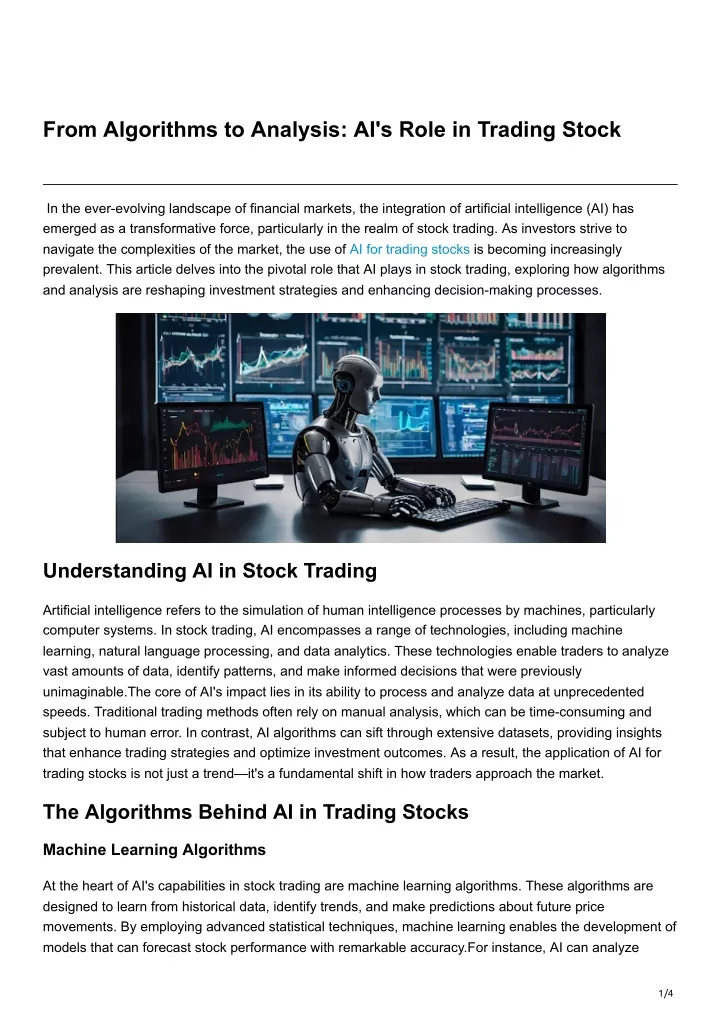Top 10 Ways To Evaluate The Integration And Compatibility Of Ai-Based Stock Predicting/Analyzing Trading Platforms
Integrity and compatibility are crucial factors when considering AI stock predicting/analyzing trading platforms. Platforms that integrate seamlessly with existing tools, workflows, and systems can enhance productivity and efficiency. We've compiled our top 10 recommendations on how to assess the compatibility and the integration of these platforms.
1. Check Brokerage Integration
Check that your platform works seamlessly with the brokerage or trading service you prefer.
Trade Execution: Check if the platform allows direct trade execution by the integrated broker.
Account synchronization: Check that the platform is able to update in real-time accounts, balances and positions and transaction history.
2. Examine API Availability
API access - Make sure that the platform comes with an API to allow developers to develop customized tools or automate workflow flows.
API documentation: Check to see if there are clear examples of how the API is used.
Rate limits. Verify that the API you're looking at has reasonable rate limitations and can handle the volume of your use.
3. Evaluation of Third-Party Tools Integration
Popular tools See if there are any connections between the platform and tools such as Google Sheets, Excel, or trading robots.
Data import/export: Make sure the platform enables easy export/import data to and from other tools.
Extensions/Plugins: Make sure that your platform is compatible with plugins or extensions to provide additional capabilities.
4. Test Compatibility Operating Systems
Desktop compatibility - Ensure that the platform you choose can be used with Windows, macOS and Linux.
Mobile compatibility: Check whether there's an application that is mobile compatible available for iOS or Android.
Access via the internet (for added flexibility): Verify that the platform is accessible using a webbrowser.
5. Assess Data Integration Capabilities
Data sources - Make sure that the platform is connected to different sources of information (e.g. news feeds, market data, sentiments on social media).
Real-time analytics: Be sure the platform integrates real-time analyses.
Historical data import: Determine if the platform allows importing historical data to backtest or analysis.
6. Examine the compatibility of cloud and on-premise
Cloud-based Platforms: The platform should be available anywhere there is an internet connection.
On-premises deployment: Find out if your platform is compatible with deployment on premises.
Look into the hybrid model. It is a hybrid model that combines on-premise and cloud capabilities.
7. Make sure to check for Cross Platform Syncronization
Device synchronization. Ensure data and settings are synced across all platforms (desktops tablets and mobiles).
Real-time updates: Verify if changes made on one device are immediately reflected on others.
Access to offline data: Determine whether your platform provides restricted functionality and access to data when offline.
8. Evaluation of compatibility with trading strategies
Automated or algorithmic trading: Verify that the platform you use for trading supports these strategies.
Custom indicators. Verify if the platform allows the use of technical indicators or scripts.
Backtesting strategies. Verify that the platform supports strategies for backtesting based on the past data.
9. Assess Security and Compliance
Data encryption: Check whether the platform is using encryption to protect data both in transit and while at rest.
Authentication: Check whether the platform supports secure authentication methods (e.g. two-factor authentication).
Regulatory compliance: Verify that the platform meets applicable regulations (e.g. GDPR, FINRA or SEC).
10. Test Scalability and Performance
Scalability: Make sure the platform is able to handle the increasing amount of users and data as your requirements grow.
Performance during load conditions: Check whether the platform continues to be flexible during market conditions with high volatility.
Resource usage - Check that the platform efficiently uses system resources like CPU, memory or bandwidth.
Bonus Tips
Feedback from users: Read reviews of users and testimonials to assess the integration capabilities of the platform.
Trial period: Take advantage of a no-cost trial or demo to discover how the platform works with other tools and processes.
Customer Support: Ensure the platform offers a solid support in connection issues.
You can assess the integration, compatibility, and efficacy of AI stock trading platforms by following these guidelines. Check out the top rated read full report for ai chart analysis for blog info including best ai for trading, using ai to trade stocks, ai chart analysis, ai trade, ai for trading, incite, ai trade, incite, using ai to trade stocks, stock ai and more.

Top 10 Suggestions For Evaluating The Social And Community Features Of Ai Stock Trading Platforms
It is crucial to know how users interact, share information and learn from one another by assessing the social and community features of AI-driven prediction platforms and trading platforms. These features can improve the user experience as well as provide valuable support. Here are the 10 best strategies for evaluating social and community features on these platforms.
1. Active User Group
TIP: Make sure that the platform has a community of users active in engaging in regular discussions, sharing their insights and giving feedback.
Why: A community that is active is an indication of a lively environment that allows users to learn and grow with each other.
2. Discussion Forums and Boards
TIP: Evaluate the quality and extent of activity on message boards or forums.
Forums are a great way for users to ask questions, discuss strategies and market trends.
3. Social Media Integration
Tips Check if your platform integrates with other social media channels like Twitter and LinkedIn to share updates and insights.
Why: Social media integration can enhance engagement and provide current market updates in real-time.
4. User-generated content
Look for features such as the ability to create and publish content.
Why? User-generated content fosters collaboration and provides a variety of perspectives.
5. Expert Contributions
Tip: Make sure the platform has contributions from experts in their field for example, AI or market analysts.
The reason is that expert perspectives provide credibility and depth to the community debate.
6. Chat, Real-Time Messaging and Chat in Real Time
TIP: Find out if users can talk to one another instantly using real-time chat or messaging.
Real-time interaction allows for quick exchange of information and collaboration.
7. Community Moderation Assistance
Tips: Evaluate the degree of moderating and support offered in the community (e.g. moderators and moderators as well as customer support representatives).
The reason: Effective moderation creates a positive and respectful environment and support assists in resolving user issues promptly.
8. Events and Webinars
Tips: Find out if the platform hosts events, webinars or live Q&A sessions with industry experts.
The reason: These events provide the opportunity to interact directly and learning with industry professionals.
9. User Reviews and Feedback
TIP: Keep an eye out for features which permit users to provide reviews or feedback on the platform and its features.
Why? User feedback helps identify strengths in the community ecosystem and areas to improve.
10. Gamification and Rewards
TIP: Find out whether there are any gamification options (e.g. badges or leaderboards) or rewards for participation.
Why: Gamification can motivate users to engage more deeply with the community and its platform.
Bonus Tip: Privacy and Security
Check that all community or other social features are backed by strong privacy and safety measures to safeguard user data and interactions.
If you take the time to thoroughly review these aspects it is possible to determine if the AI software for stock predictions and trading has a supportive and engaging community that can enhance your trading experience and knowledge. Have a look at the recommended my sources for blog advice including best ai stock prediction, ai share trading, best ai stock prediction, ai in stock market, ai stock price prediction, free ai tool for stock market india, how to use ai for stock trading, free ai tool for stock market india, stock predictor, trading ai tool and more.

Comments on “20 Pro Info On Choosing AI Stock Predictions Analysis Websites”